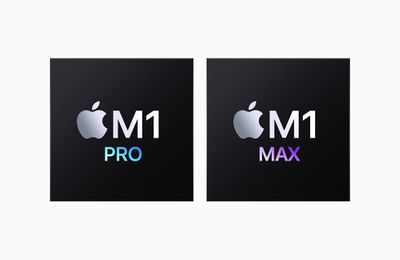Apple at its "Unleashed" event today announced the M1 Pro and M1 Max processors, two custom-built successor chips to the original M1 Apple silicon chip. The new MacBook Pros are powered by the new chips, which deliver up to 70% faster CPU performance than the M1.

The M1 Pro features up to 10 CPU cores, with eight high-performance and two energy-efficient cores. In terms of graphics, the M1 Pro has a 16-core GPU, which is up to twice as powerful as the M1. It has up to 200GB/s of memory bandwidth, using 33.7 billion transistors, and supports up to 32GB of unified memory.
The M1 Max builds on the M1 Pro and starts by doubling the memory interface, delivering up to 400 GB/s memory bandwidth, and supports up to 64GB of unified memory with 57 billion transistors. It has the same 10-core CPU, but a 32-core GPU that's up to seven times faster, and is similar performance to discrete graphics while using 70% less power.
"M1 has transformed our most popular systems with incredible performance, custom technologies, and industry-leading power efficiency. No one has ever applied a system-on-a-chip design to a pro system until today with M1 Pro and M1 Max," said Johny Srouji, Apple's senior vice president of Hardware Technologies. "With massive gains in CPU and GPU performance, up to six times the memory bandwidth, a new media engine with ProRes accelerators, and other advanced technologies, M1 Pro and M1 Max take Apple silicon even further, and are unlike anything else in a pro notebook."
The efficient architecture of M1 Pro and M1 Max means they deliver the same level of performance whether MacBook Pro is plugged in or using the battery, says Apple. The M1 Pro and M1 Max also feature enhanced media engines with dedicated ProRes accelerators specifically for pro video processing.
Compared to a powerful discrete GPU for PC notebooks, M1 Pro delivers more performance while using up to 70 percent less power, according to Apple. As for the M1 Max, Apple says the GPU delivers performance comparable to a high-end GPU in a compact pro PC laptop while consuming up to 40 percent less power, and performance similar to that of the highest-end GPU in the largest PC laptops while using up to 100 watts less power.
The M1 Pro includes dedicated acceleration for the ProRes professional video codec, allowing playback of multiple streams of high-quality 4K and 8K ProRes video while using very little power. Meanwhile, the M1 Max delivers up to 2x faster video encoding than the M1 Pro, and features two ProRes accelerators. With M1 Max, the new MacBook Pro can transcode ProRes video in Compressor up to 10x faster compared with the previous-generation 16-inch MacBook Pro.
Both the M1 Pro and M1 Max feature a 16-core Neural Engine for on-device machine learning acceleration and improved camera performance, a new display engine that drives multiple external displays, additional integrated Thunderbolt 4 controllers, Apple's custom image signal processor and Neural Engine, as well as Apple's latest Secure Enclave, hardware-verified secure boot, and runtime anti-exploitation technologies.
The new M1 Pro and M1 Max power the new 14-inch MacBook Pro and 16-inch MacBook Pro, both of which are available to pre-order from Apple starting today.
























